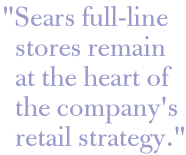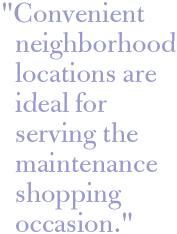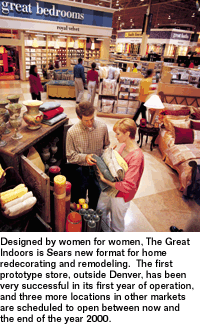|
Sears full-line stores, located in many of the nation's finest shopping malls, remain at the
heart of the company's retail strategy. Their dramatic transformation over the past five
years speaks to Sears commitment to create a compelling shopping destination for the
American consumer.
Fifty-seven million square feet of space in these stores has been remodeled since 1993. More
than 14 million square feet of selling space has been added in apparel departments alone,
through remodels, expansions and new stores. Today, two out of every three square feet of
selling space is dedicated to apparel, accessories and home fashions, key shopping categories
for Sears target female customer.
 Sears also is adding new full-line stores. Of the 23 built in 1998, 11 were relocated stores
for a net gain of 12, bringing the total to 845 nationwide. Going forward, plans call for
constructing 18 to 25 new stores in 1999, 6 to 8 of which will be relocations, for a net gain
of 12 to 17 stores. Some of these stores will serve urban locations, where higher real estate
and operational costs are offset by greater store traffic and productivity. Some will be in
smaller markets that have been underserved by national retailers of Sears quality.
Sears also is adding new full-line stores. Of the 23 built in 1998, 11 were relocated stores
for a net gain of 12, bringing the total to 845 nationwide. Going forward, plans call for
constructing 18 to 25 new stores in 1999, 6 to 8 of which will be relocations, for a net gain
of 12 to 17 stores. Some of these stores will serve urban locations, where higher real estate
and operational costs are offset by greater store traffic and productivity. Some will be in
smaller markets that have been underserved by national retailers of Sears quality.
Sears full-line stores offer a complete line of merchandise - apparel and other softgoods,
home and automotive products, and the company's legendary hardgoods, including hardware, home
improvement products, appliances and electronics. Sales performance in 1998 was affected by
increasing competition in apparel from discounters and department stores, which partially
offset solid hardgoods results in home appliances, electronics, and lawn and garden.
Powerful stable of brands in softgoods and hardgoods
To strengthen its apparel business, Sears will clarify its offerings by reducing the number
of suppliers while continuing to develop private apparel brands such as Crossroads and
Apostrophe for women, Fieldmaster and CRB Khakis for men, TKS Basics for kids and Canyon
River Blues for the entire family. In addition, proprietary and national brands will be
showcased more effectively through new in-store boutiques similar to those found in
department stores. Successful examples include Sears exclusive Circle of Beauty and Time Out
cosmetics lines that are displayed in fashionable kiosks in 410 and 600 Sears stores,
respectively.
 In hardgoods, the addition of Maytag appliances for the full-year 1998 makes Sears the only
retailer to offer consumers all six major appliance brands: Amana, Frigidaire, General
Electric, Maytag, Whirlpool and Kenmore, the number one selling appliance brand in the
country and found in one out of every two American homes. The company will continue to
build its market share in appliances through brand selection, price leadership, credit and
service, as well as innovative new products. Introduced in 1998, for example, the Kenmore
Microwave Hood Combination exceeded sales expectations, and the Kenmore SmartReach
refrigerator with freezer on the bottom was added to specialty refrigerator products.
In hardgoods, the addition of Maytag appliances for the full-year 1998 makes Sears the only
retailer to offer consumers all six major appliance brands: Amana, Frigidaire, General
Electric, Maytag, Whirlpool and Kenmore, the number one selling appliance brand in the
country and found in one out of every two American homes. The company will continue to
build its market share in appliances through brand selection, price leadership, credit and
service, as well as innovative new products. Introduced in 1998, for example, the Kenmore
Microwave Hood Combination exceeded sales expectations, and the Kenmore SmartReach
refrigerator with freezer on the bottom was added to specialty refrigerator products.
In home electronics, where big screen televisions and camcorders are best sellers, especially
during the holiday shopping season, emphasis will be placed on high-end brands such as
Sony.
In hardware, Craftsman products continue to define Sears authority in tools, complemented by
nationally-recognized brands such as DeWalt and Makita. In 1998, American consumers ranked
Craftsman second among all national brands based on quality. Customers responded
enthusiastically to Craftsman Driver Light, a lighted screwdriver, and Craftsman Redi Drill,
a 12-volt drill with drill bits stored inside for easy changing - just two of the 60 new
tools introduced in 1998.
 The company has made great strides in diversifying its retail presence geographically and
now operates more than 2,000 specialty stores nationwide. Most of these stores are in
free-standing, off-the-mall locations or high-traffic neighborhood shopping centers. They
are accessible to a large number of American families and include hardware stores, dealer
stores and automotive stores. The latest format is The Great Indoors, a new concept in home
remodeling and redecorating. The company has made great strides in diversifying its retail presence geographically and
now operates more than 2,000 specialty stores nationwide. Most of these stores are in
free-standing, off-the-mall locations or high-traffic neighborhood shopping centers. They
are accessible to a large number of American families and include hardware stores, dealer
stores and automotive stores. The latest format is The Great Indoors, a new concept in home
remodeling and redecorating.
Home stores performed well in 1998
Sears continued to integrate its two hardware store formats in 1998 - Sears Hardware and
Orchard Supply Hardware - based on a "supermarket" design that combines the best features
of each. Sears Hardware continued its expansion, opening nine new stores in the Northeast
in 1998, while Orchard Supply Hardware, a California chain acquired in 1996, opened nine
new stores in California. Eight stores that did not meet financial and format criteria were
closed, while the company plans another 20 to 30 openings in 1999.
 Both Sears Hardware and Orchard offer convenient neighborhood locations that are ideal for
serving the maintenance shopping occasion. They also provide additional outlets where
customers can purchase Sears exclusively branded products, including Craftsman tools,
WeatherBeater and Easy Living paints, Kenmore appliances and DieHard batteries. Both Sears Hardware and Orchard offer convenient neighborhood locations that are ideal for
serving the maintenance shopping occasion. They also provide additional outlets where
customers can purchase Sears exclusively branded products, including Craftsman tools,
WeatherBeater and Easy Living paints, Kenmore appliances and DieHard batteries.
Another of Sears innovative formats, locally-owned and operated dealer stores, continued to
grow rapidly - to 653 units at year-end 1998. Called America's rural superstore for
appliances, electronics, tools and lawn and garden equipment, they serve smaller communities.
Sears added 77 dealer stores in 1998 and plans an additional 170 stores in 1999, which will
bring the total to more than 800 nationwide.
The company also demonstrated its commitment to innovation by opening a 150,000 square-foot
prototype store to serve as the woman shopper's single destination for home decorating and
remodeling projects. Called The Great Indoors, the store opened in early 1998 near Denver,
Colo., and finished the year with strong results. It is designed by women for women and
emphasizes the four basic rooms of the home: kitchen, bedroom, bathroom and great room.
Current plans call for three additional stores by late 2000.
Changes refocus Sears automotive business
In 1998, Sears refocused its automotive business, which now consists of 789 Sears Auto
Centers and 347 free-standing NTB National Tire & Battery stores. The company merged its
Western Auto and Parts America businesses with Advance Holdings, Inc., the operator of 915
auto parts and accessories stores in 17 states, for cash and approximately 40 percent of
the common stock of Advance. This allows Sears to focus on its core position as the nation's
number one retailer of tires and batteries, having sold 19.2 million tires and 5.9 million
batteries in 1998.
Sears automotive business now operates through two formats, Sears Auto Centers and NTB.
Each format is unique, and taps into different customer shopping expectations and behaviors,
although both have the ultimate objective of providing peace of mind to customers. The Sears
Auto Center customer has a preference for shopping "on-the-mall," and likes the excellent
values and the broad assortment Sears offers. NTB provides "off-the-mall" growth as the
industry expert, with competitive prices, nationally branded products, and associates
skilled in solving customers' problems.
|

 Sears also is adding new full-line stores. Of the 23 built in 1998, 11 were relocated stores
for a net gain of 12, bringing the total to 845 nationwide. Going forward, plans call for
constructing 18 to 25 new stores in 1999, 6 to 8 of which will be relocations, for a net gain
of 12 to 17 stores. Some of these stores will serve urban locations, where higher real estate
and operational costs are offset by greater store traffic and productivity. Some will be in
smaller markets that have been underserved by national retailers of Sears quality.
Sears also is adding new full-line stores. Of the 23 built in 1998, 11 were relocated stores
for a net gain of 12, bringing the total to 845 nationwide. Going forward, plans call for
constructing 18 to 25 new stores in 1999, 6 to 8 of which will be relocations, for a net gain
of 12 to 17 stores. Some of these stores will serve urban locations, where higher real estate
and operational costs are offset by greater store traffic and productivity. Some will be in
smaller markets that have been underserved by national retailers of Sears quality.
 In hardgoods, the addition of Maytag appliances for the full-year 1998 makes Sears the only
retailer to offer consumers all six major appliance brands: Amana, Frigidaire, General
Electric, Maytag, Whirlpool and Kenmore, the number one selling appliance brand in the
country and found in one out of every two American homes. The company will continue to
build its market share in appliances through brand selection, price leadership, credit and
service, as well as innovative new products. Introduced in 1998, for example, the Kenmore
Microwave Hood Combination exceeded sales expectations, and the Kenmore SmartReach
refrigerator with freezer on the bottom was added to specialty refrigerator products.
In hardgoods, the addition of Maytag appliances for the full-year 1998 makes Sears the only
retailer to offer consumers all six major appliance brands: Amana, Frigidaire, General
Electric, Maytag, Whirlpool and Kenmore, the number one selling appliance brand in the
country and found in one out of every two American homes. The company will continue to
build its market share in appliances through brand selection, price leadership, credit and
service, as well as innovative new products. Introduced in 1998, for example, the Kenmore
Microwave Hood Combination exceeded sales expectations, and the Kenmore SmartReach
refrigerator with freezer on the bottom was added to specialty refrigerator products.
 The company has made great strides in diversifying its retail presence geographically and
now operates more than 2,000 specialty stores nationwide. Most of these stores are in
free-standing, off-the-mall locations or high-traffic neighborhood shopping centers. They
are accessible to a large number of American families and include hardware stores, dealer
stores and automotive stores. The latest format is The Great Indoors, a new concept in home
remodeling and redecorating.
The company has made great strides in diversifying its retail presence geographically and
now operates more than 2,000 specialty stores nationwide. Most of these stores are in
free-standing, off-the-mall locations or high-traffic neighborhood shopping centers. They
are accessible to a large number of American families and include hardware stores, dealer
stores and automotive stores. The latest format is The Great Indoors, a new concept in home
remodeling and redecorating.
 Both Sears Hardware and Orchard offer convenient neighborhood locations that are ideal for
serving the maintenance shopping occasion. They also provide additional outlets where
customers can purchase Sears exclusively branded products, including Craftsman tools,
WeatherBeater and Easy Living paints, Kenmore appliances and DieHard batteries.
Both Sears Hardware and Orchard offer convenient neighborhood locations that are ideal for
serving the maintenance shopping occasion. They also provide additional outlets where
customers can purchase Sears exclusively branded products, including Craftsman tools,
WeatherBeater and Easy Living paints, Kenmore appliances and DieHard batteries.